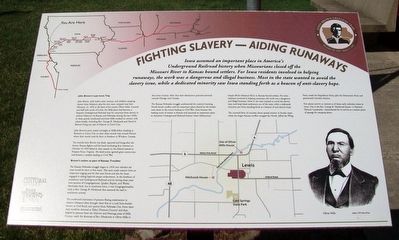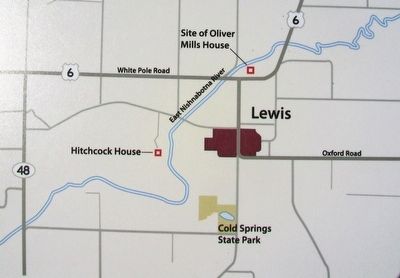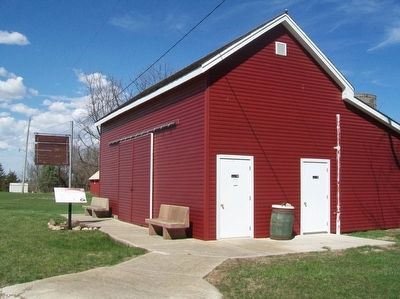Fighting Slavery – Aiding Runaways
John Brown Freedom Trail
— December 20, 1858 - March 12, 1859 —
Iowa assumed an important place in America’s Underground Railroad history when Missourians closed off the Missouri River to Kansas bound settlers. For Iowa residents involved in helping runaways, the work was a dangerous and illegal business. Most in the state wanted to avoid the slavery issue, while a dedicated minority saw Iowa standing forth as a beacon of anti-slavery hope.
John Brown’s Last Iowa Trip
John Brown, with twelve men, women, and children escaping slavery from Missouri, plus his own men, stopped near here February 13, 1859 at the farm of his cousin Oliver Mills. Located one-half mile north of Lewis, the Mills place had become a frequent Underground Railroad stop for runaways from slavery in western Missouri via Kansas and Nebraska during the late 1850s. In these quietly conducted activities Mills worked in concert with others locally, including Rev. George B. Hitchcock and David A. Barnett living just east of Atlantic at Grove City.
John Brown’s party rested overnight at Mills before heading to Barnett’s at Grove City on their three month trek toward Detroit where they would cross by ferry to freedom in Windsor, Canada.
Ten months later Brown was dead, captured and hung after the former Kansas fighter and his band (including four Iowans) on October 16 1859 failed in their assault on the federal
arsenal at Harpers Ferry, Virginia. The bold action ignited great controversy and became a catalyst leading to Civil War.
Brown’s action as part of Kansas Troubles
The Kansas-Nebraska struggle began in 1854 over whether the areas would be slave or free states. This soon made western Iowa an important staging area for free state forces and also for those engaged in aiding fugitives escape enslavement. In the forefront of antislavery and Underground Railroad activity during these years were persons of Congregational, Quaker, Baptist, and Wesley Methodist faith, but in southwest Iowa, it was Congregationalists such as Rev. George B. Hitchcock that assumed the lead in antislavery activity.
The northward movement of persons fleeing enslavement in western Missouri often brought them first to a rural Iowa hamlet known as Civil Bend, just upriver from Nebraska City. From there they would be directed to Tabor (Fremont County) and then, helped by persons from the Malvern and Hastings areas of Mills County, reach the doorsteps of Rev. Hitchcock or Oliver Mills in the Lewis vicinity. After that their destination pointed eastward toward Chicago and Canada.
The Kansas-Nebraska struggle underscored the nation’s looming North-South conflict and the important place shared by the border west states in the events leading to Civil War. Iowa became the leading route of transit
The outward flow of runaway slaves spread tensions in border states while the larger Kansas conflict enraged the North, killed the Whig Party, made the Republican Party, split the Democratic Party and guaranteed Lincoln’s election.
Few places survive to remind us of those early turbulent times in Iowa. One is the Rev. George B. Hitchcock house–a National Historic Landmark–remembered for its service as a station point of passage for escaping slaves.
[Image of] Oliver Mills [from] Andreas 1875 Atlas of Iowa
Erected by Iowa Dept of Cultural Affairs, State Historical Society of Iowa, and Iowa Dept of Transportation.
Topics. This historical marker is listed in these topic lists: Abolition & Underground RR • Settlements & Settlers. A significant historical date for this entry is February 13, 1859.
Location. 41° 18.237′ N, 95° 6.223′ W. Marker is near Lewis
Other nearby markers. At least 8 other markers are within 6 miles of this marker, measured as the crow flies. Rev. George B. Hitchcock House (a few steps from this marker); The Mormon Pioneer Trail / A Warm Welcome on the Nishnabotna (about 300 feet away, measured in a direct line); The Mormon Pioneer Trail / A Road and River, Well Traveled (approx. 0.6 miles away); Memorial Building (approx. ¾ mile away); The Mormon Trail (approx. ¾ mile away); World Wars Memorial (approx. ¾ mile away); Lewis Freedom Rock Veterans Memorial (approx. 1.3 miles away); Veterans Memorial (approx. 5.2 miles away). Touch for a list and map of all markers in Lewis.
Also see . . .
1. Hitchcock House on the Underground Railroad. (Submitted on April 13, 2016, by William Fischer, Jr. of Scranton, Pennsylvania.)
2. John Brown's Holy War: The Missouri Raid, at American Experience. (Submitted on April 13, 2016, by William Fischer, Jr. of Scranton, Pennsylvania.)
3. Iowa and the Underground Railroad. (Submitted on April 13, 2016, by William Fischer, Jr. of Scranton, Pennsylvania.)
4. Bleeding Kansas. (Submitted on April 13, 2016, by William Fischer, Jr. of Scranton, Pennsylvania.)
Credits. This page was last revised on June 16, 2016. It was originally submitted on April 13, 2016, by William Fischer, Jr. of Scranton, Pennsylvania. This page has been viewed 533 times since then and 26 times this year. Photos: 1, 2, 3. submitted on April 13, 2016, by William Fischer, Jr. of Scranton, Pennsylvania.


